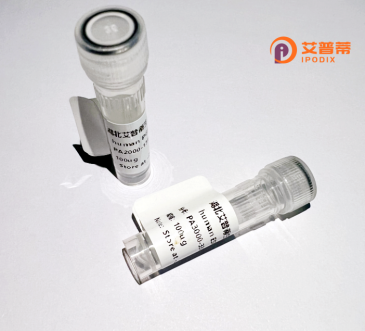
| 纯度 | >90%SDS-PAGE. |
| 种属 | Human |
| 靶点 | SLC22A5 |
| Uniprot No | O76082 |
| 内毒素 | < 0.01EU/μg |
| 表达宿主 | E.coli |
| 表达区间 | 42-142 aa |
| 活性数据 | LIATPEHRCRVPDNLSSAWRNHTVPLRLRDGREVPHSCRRYRLATIANFSALGLEPGRDVDLGQLEQESCLDGWEFSQDVYLSTIVTEWNLVCEDDWKA |
| 分子量 | 18.4 kDa |
| 蛋白标签 | His tag N-Terminus |
| 缓冲液 | PBS, pH7.4, containing 0.01% SKL, 1mM DTT, 5% Trehalose and Proclin300. |
| 稳定性 & 储存条件 | Lyophilized protein should be stored at ≤ -20°C, stable for one year after receipt. Reconstituted protein solution can be stored at 2-8°C for 2-7 days. Aliquots of reconstituted samples are stable at ≤ -20°C for 3 months. |
| 复溶 | Always centrifuge tubes before opening.Do not mix by vortex or pipetting. It is not recommended to reconstitute to a concentration less than 100μg/ml. Dissolve the lyophilized protein in distilled water. Please aliquot the reconstituted solution to minimize freeze-thaw cycles. |
以下是关于重组人SLC22A5(OCTN2)蛋白的参考文献及摘要概括:
1. **"Functional characterization of recombinant human carnitine transporter OCTN2 (SLC22A5) in mammalian cells"**
- **作者**: Tamai I, et al.
- **摘要**: 本研究在哺乳动物细胞(HEK293)中成功表达了重组人OCTN2蛋白,验证其肉碱转运功能及钠离子依赖性,并证实其在原发性肉碱缺乏症(PCD)相关突变中的功能丧失机制。
2. **"Expression and functional analysis of OCTN2 (SLC22A5) variants in a cell-based model"**
- **作者**: Lahjouji K, et al.
- **摘要**: 通过重组表达多个OCTN2突变体,揭示了突变导致肉碱转运能力降低或底物结合缺陷,为PCD的分子机制提供实验依据。
3. **"Reconstitution of carnitine transport activity by recombinant OCTN2 in liposomes"**
- **作者**: Urban TJ, et al.
- **摘要**: 在脂质体中重构重组OCTN2蛋白,证明其介导肉碱跨膜转运的能力,并利用该系统评估药物对肉碱吸收的潜在抑制作用。
4. **"Structural insights into human OCTN2 transport mechanism by cryo-EM"**
- **作者**: Wright NJ, et al.
- **摘要**: 通过冷冻电镜解析重组OCTN2蛋白的高分辨率结构,阐明其底物识别和钠离子协同转运的分子基础,为靶向治疗提供结构依据。
以上研究聚焦于SLC22A5的重组表达、功能验证、疾病相关突变分析及结构解析,为理解其在肉碱代谢和疾病中的作用提供了关键证据。
The solute carrier family 22 member 5 (SLC22A5), also known as organic cation/carnitine transporter 2 (OCTN2), is a transmembrane protein critical for carnitine homeostasis. Primarily expressed in tissues with high energy demands, such as skeletal muscle, heart, liver, and kidneys, it facilitates sodium-dependent uptake of carnitine—a molecule essential for transporting long-chain fatty acids into mitochondria for β-oxidation and ATP production. SLC22A5 mutations cause primary systemic carnitine deficiency (SCD), an autosomal recessive disorder characterized by metabolic dysfunction, cardiomyopathy, and muscle weakness. Recombinant human SLC22A5 protein, typically produced in heterologous expression systems (e.g., mammalian cells or bacteria), serves as a tool to study transport mechanisms, substrate specificity, and drug interactions. Structurally, it features 12 transmembrane domains and conserved binding sites for cations and organic molecules. Research on recombinant SLC22A5 aids in developing therapeutic strategies for SCD and understanding its role in drug pharmacokinetics, as it may interact with antibiotics, antivirals, and chemotherapeutics. Its study also contributes to insights into nutrient-drug interplay and personalized medicine approaches targeting transport-related pathologies.
×